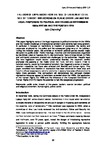The Assessment of Floating Offshore Wind Turbines in Extreme Conditions
| dc.contributor.supervisor | Greaves, Deborah | |
| dc.contributor.author | White, Andre Onife Alwyn | |
| dc.contributor.other | Faculty of Science and Engineering | en_US |
| dc.date.accessioned | 2024-02-28T11:55:44Z | |
| dc.date.available | 2024-02-28T11:55:44Z | |
| dc.date.issued | 2024 | |
| dc.identifier | 10598814 | en_US |
| dc.identifier.uri | https://pearl.plymouth.ac.uk/handle/10026.1/22108 | |
| dc.description.abstract |
The purpose of this research is to assess if a floating offshore wind turbine (FOWT) system that is suitable for the environmental conditions in the Scottish North Sea (SNS) is also suitable for the environmental conditions in the Jamaica Caribbean Sea (JCS). A FOWT within Jamaica is an important structure because it produces renewable energy which helps to reduce the dependence on fossil fuel as the primary source of energy. At the same time, it also contributes to reducing global warming caused by climate change effects. These structures, therefore, must be robust enough to withstand the most extreme environmental conditions in the JCS. The extreme sea and wind conditions are determined in the JCS and the SNS and used as inputs to an OpenFAST numerical model to determine the floater dynamic and structural response. Hindcast environmental data at appropriate site locations is sourced from the European Centre for Medium Range Weather Forecasts (ECMWF) repository. The data is used to compute the normal sea and wind conditions and the extreme (50-year return period) sea and wind conditions. The extreme conditions are determined using extreme value analysis and the environmental contour method. The responses of the FOWT system are determined using OpenFAST software code for a baseline OpenFAST floating wind turbine model, available for download on Github. In the initial design of the research only the 50-year extreme sea state and wind conditions were computed and used to compare the response of the FOWT in the JCS and the SNS but the study is extended to include the hurricane wind and sea conditions in the JCS as this is the most extreme condition within the jurisdiction. The response of the FOWT system within the JCS are then compared using the 50-year extreme loads and the hurricane loads. The hurricane loads are found using data from a large eddy simulation (LES) model of a category 5 hurricane within the North Atlantic. The research shows that the 3 parameter Weibull statistical distribution (Weib3P) which is suitable to fit hindcast data to determine the 50-year extreme sea state for the SNS is not appropriate for the JCS. To determine the 50-year extreme sea state for the JCS, the Weib3P distribution model is fitted to hurricane wave height data. For the extreme 50-year conditions the dynamic response of the floater and the structure are predominantly greater in the JCS than the SNS. For example, the surge motion in the JCS of 28.6 m is 1.2 times the value in the SNS. The heave motion of 6.0 m in the JCS is 1.1 times the value in the SNS. The pitch motion of 9.1 deg in the JCS is 1.7 times the value in the SNS. For the 50-year response compared to the hurricane loads, all of the responses of the FOWT are greater for the hurricane loads. For example, the maximum tension in the mooring line is 2.38E+07 N for the hurricane is 4.43 times the tension for the 50-year extreme case. The blades, the mooring lines and the tower are at a greater risk of failure when hurricane conditions are considered. These findings show that a more robust FOWT system is required in the JCS when hurricane conditions are considered. The extreme environmental conditions determined for the JCS in this research can be used as a basis for investigating the response of other FOWT models or even fixed-bottom models where that becomes necessary. The approach can also be used to investigate the responses of FOWT systems in other regions of the Caribbean. | en_US |
| dc.language.iso | en | |
| dc.publisher | University of Plymouth | |
| dc.rights | Attribution-NonCommercial-NoDerivs 3.0 United States | * |
| dc.rights.uri | http://creativecommons.org/licenses/by-nc-nd/3.0/us/ | * |
| dc.subject | Extreme value analysis | en_US |
| dc.subject | Floating offshore wind turbine | en_US |
| dc.subject | Hurricanes | en_US |
| dc.subject | ECMWF | en_US |
| dc.subject | GPD distribution | en_US |
| dc.subject | GEV distribution | en_US |
| dc.subject | OpenFAST | en_US |
| dc.subject | Extreme conditions | en_US |
| dc.subject | Extreme sea and extreme wind speed | en_US |
| dc.subject.classification | PhD | en_US |
| dc.title | The Assessment of Floating Offshore Wind Turbines in Extreme Conditions | en_US |
| dc.type | Thesis | |
| plymouth.version | publishable | en_US |
| dc.identifier.doi | http://dx.doi.org/10.24382/5154 | |
| dc.rights.embargoperiod | No embargo | en_US |
| dc.type.qualification | Doctorate | en_US |
| rioxxterms.version | NA | |
| plymouth.orcid_id | 0000-0002-0265-947X | en_US |
Files in this item
This item appears in the following Collection(s)
-
01 Research Theses Main Collection
Research Theses Main




